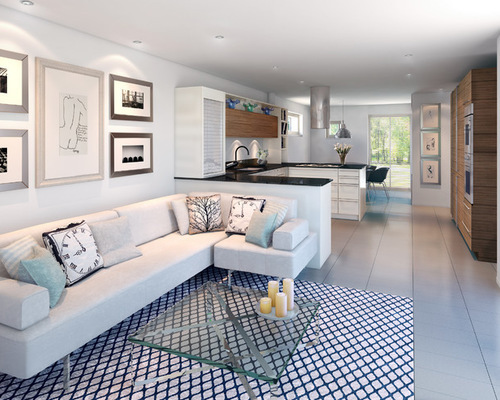Open-plan living spaces have many advantages for family life and entertaining, and they increase the opportunity to bring lots of natural light into your home. But they can end up being quite noisy. You may be surprised, however, at how easy it is to reduce sound travel with a few key additions to your furnishings. There are also structural changes you can make if you’re after a more robust fix.
Related: 8 Architectural Tricks to Enhance an Open-Plan Space
1. Dress your windows.
Large areas of glass, such as big windows and glass doors, act as bouncing-off points for sound to travel in an open-plan room. Introducing curtains will help deaden the noise. A sheer fabric works especially well, as it won’t totally block the light or views.
For maximum muffling, curtains work better than blinds, simply because there’s so much more fabric involved.
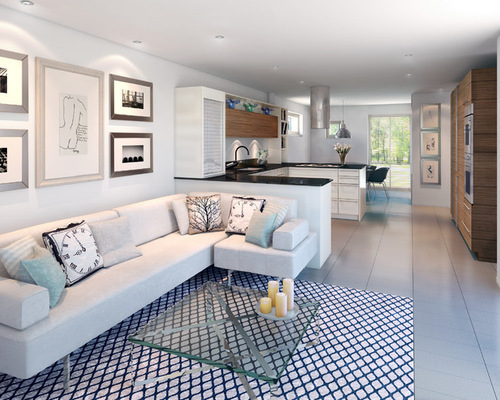
Reduce Noise 1: Environ Communities Ltd, original photo on Houzz
2. Introduce rugs.
Another way to deaden sound is to cover hard floors with rugs. Here, the use of a rug in the living space both minimizes noise and helps define the seating area, making the room feel more intimate.
When it comes to rugs, the thicker the pile, the better the soundproofing, so a cut-pile rug will tend to work better than a flat-weave design.
Reduce Noise 2: HelsingHouse Fastighetsmaklare, original photo on Houzz
3. Break it up. If you can, try to break up your open-plan space to create zones. This will also help contain the noise. Here, the fireplace in a freestanding wall maintains a visual connection with the space beyond while breaking up the room to create a more defined living area.
If you want to incorporate a feature like this, bear in mind that you’ll need to position the fireplace so you can create a flue, which will need to go through the ceiling or an external wall.
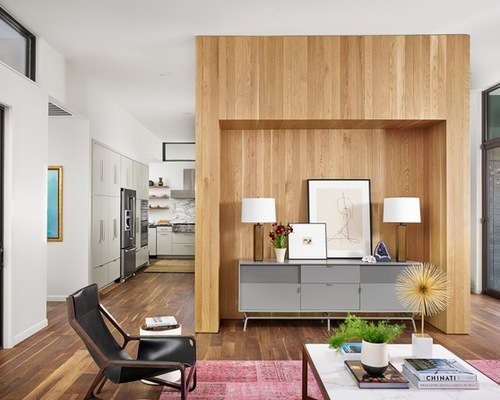
Reduce Noise 3: Stuart Sampley Architect, original photo on Houzz
4. Add a storage wall. The wood-paneled wall in the middle of this large room works beautifully to separate the kitchen from the living area. This kind of feature can be a freestanding structure or a custom piece of furniture, making it a relatively easy and cost-effective solution to break up the space, since you won’t require any structural elements.
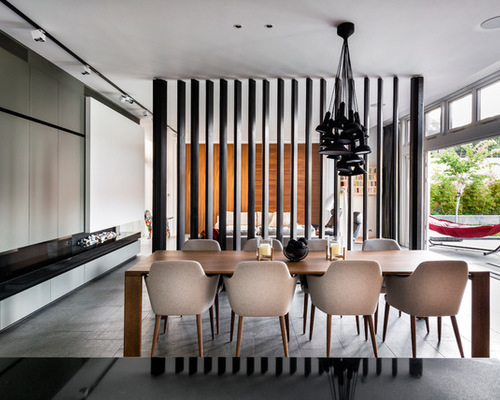
Reduce Noise 4: DTDA pty ltd, original photo on Houzz
5. Fit a feature screen. If you can’t bring yourself to divide the space with something permanent, a nice alternative is to introduce a screen as a buffer between zones. It won’t be as effective as a solid structure, but it will help diffuse the noise slightly. The louvered screen seen here allows a glimpse of the living space beyond.
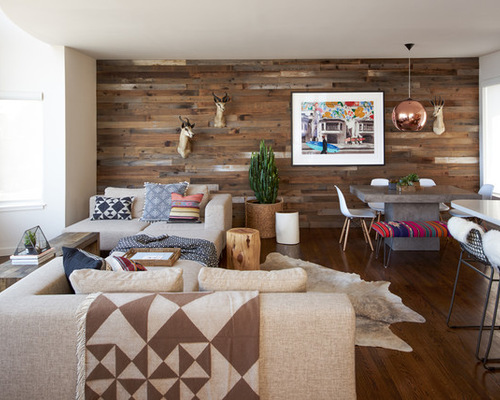
Reduce Noise 5: Studio Revolution, original photo on Houzz
6. Panel your walls. Large, flat, hard surfaces can amplify sound, so adding texture will help reduce this effect. Lining one of your walls with wood not only creates an interesting feature, it does the sound-dampening job. It’s as simple as using flooring material on the walls instead. For a more traditional look, painted wood paneling works equally well.
Often, walls aren’t completely flat, so you’ll first need to add wood battens to the surface onto which you’ll attach your paneling. A good flooring contractor or woodworker can do this, or if you’re pretty confident at DIY, you could tackle it yourself.
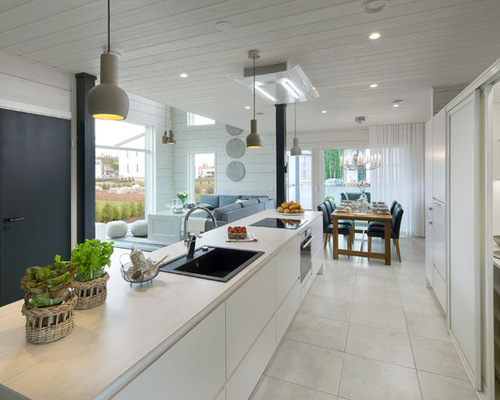
Reduce Noise 6: Honka UK Ltd, original photo on Houzz
7. Bring texture to your ceiling. Just like walls, a large expanse of ceiling will encourage the spread of sound, so try adding a textured surface there too. In this example, the ceiling and walls have been paneled with wood boards painted white.
8. Fashion fabric panels. If wood isn’t your style, consider covering one of your walls with some form of acoustic material. These padded fabric panels are highly effective at deadening sound. You can also buy off-the-shelf acoustic panel systems, which can be fixed to your walls and are easy to install.
9. Go soft underfoot. Hard floor surfaces, such as tile, are less than ideal when it comes to controlling noise, so consider something like linoleum instead, which is a durable and practical finish in a kitchen. It’s also soft underfoot, meaning it will absorb the clunk and clatter of cooking.
By Denise O’Connor, Houzz
 Facebook
Facebook
 X
X
 Pinterest
Pinterest
 Copy Link
Copy Link
